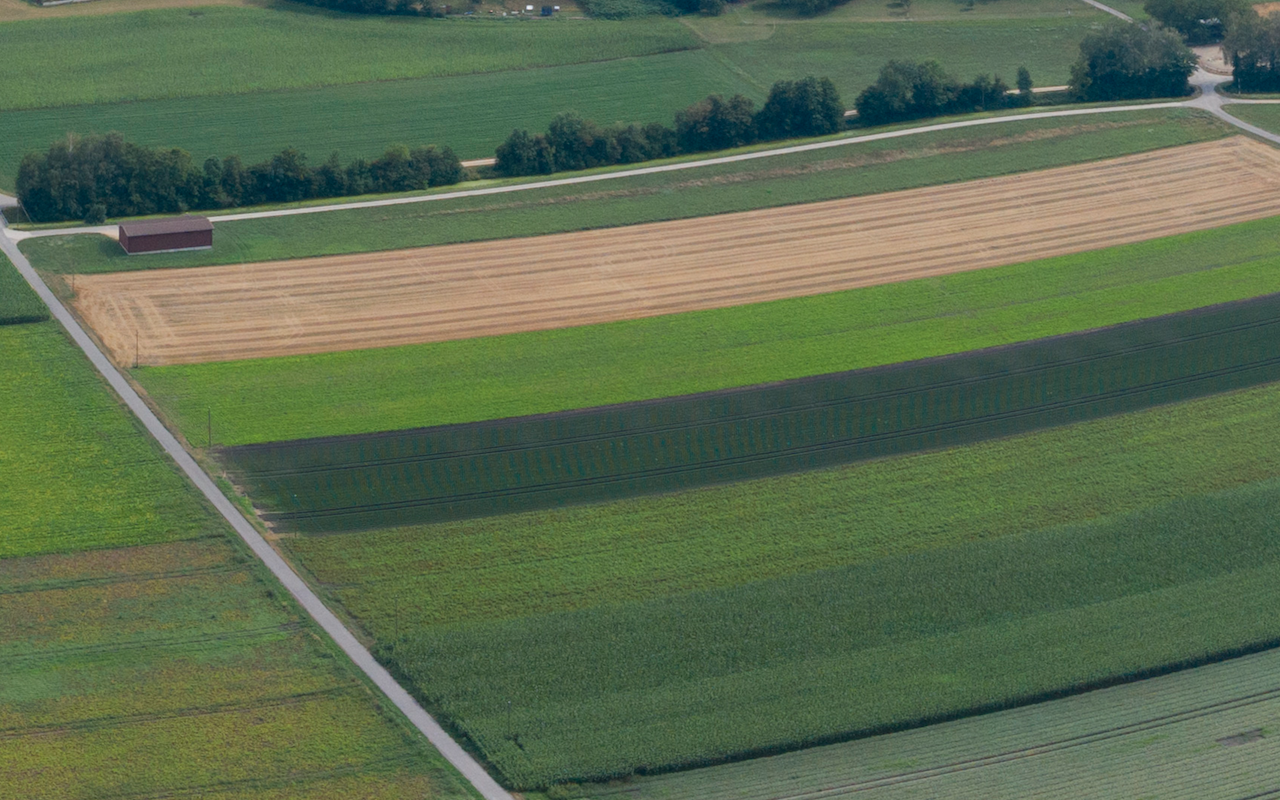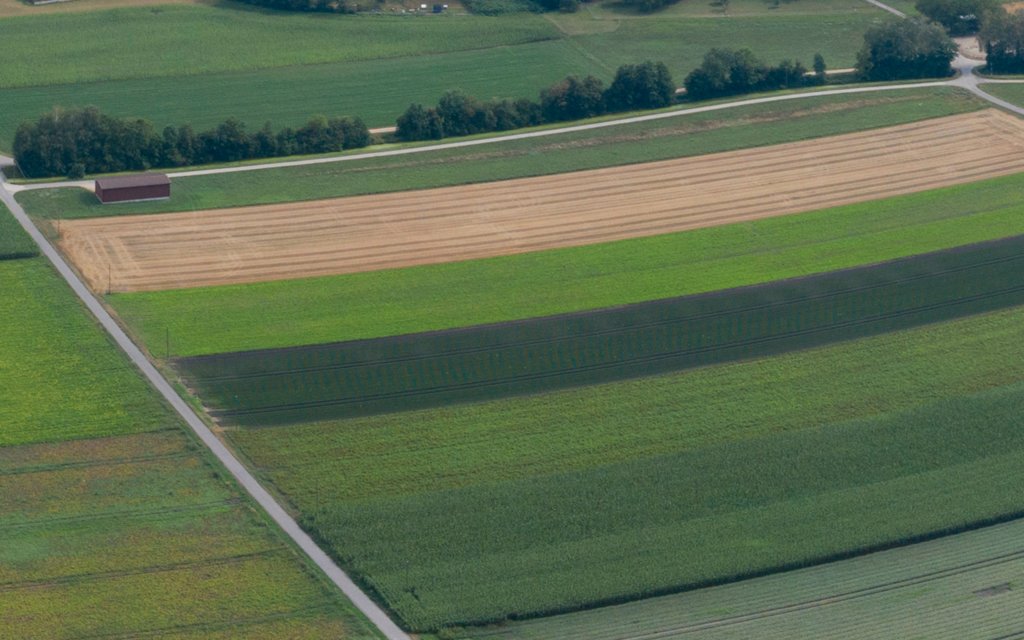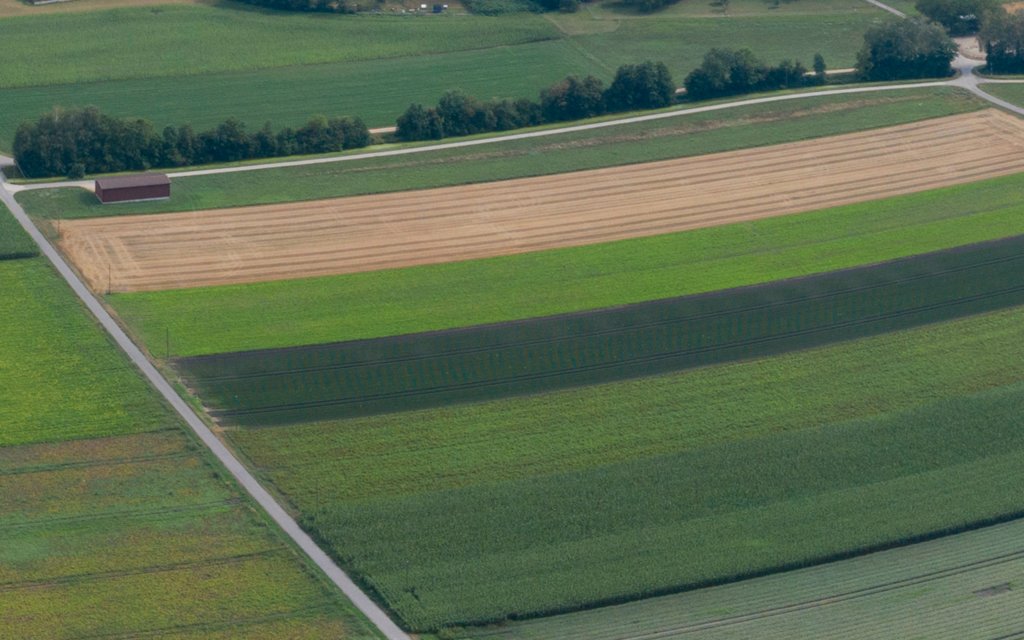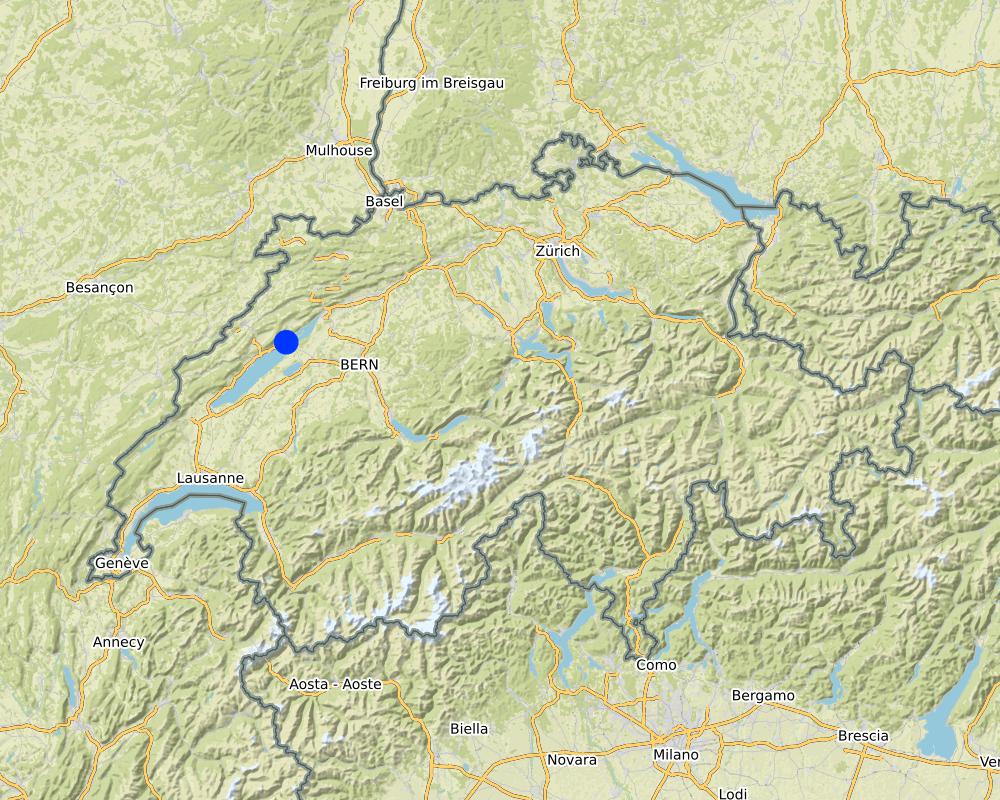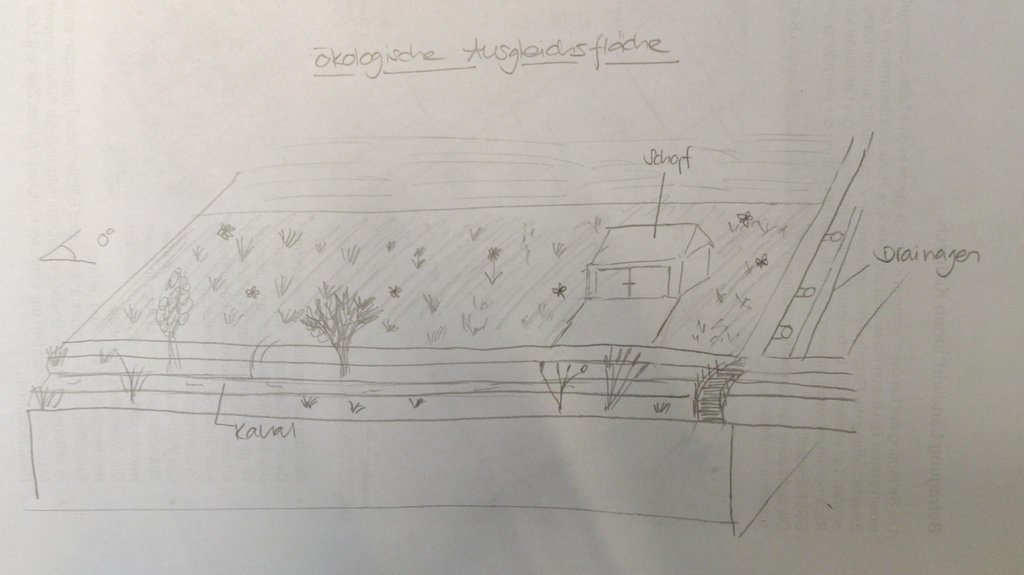Ökologische Ausgleichsfläche [Switzerland]
- Creation:
- Update:
- Compiler: Julian Meier
- Editor: Aline Wicki
- Reviewers: Hanspeter Liniger, Rima Mekdaschi Studer
Ökofläche
technologies_5839 - Switzerland
View sections
Expand all Collapse all1. General information
1.2 Contact details of resource persons and institutions involved in the assessment and documentation of the Technology
1.3 Conditions regarding the use of data documented through WOCAT
The compiler and key resource person(s) accept the conditions regarding the use of data documented through WOCAT:
Ja
1.4 Declaration on sustainability of the described Technology
Is the Technology described here problematic with regard to land degradation, so that it cannot be declared a sustainable land management technology?
Ja
2. Description of the SLM Technology
2.1 Short description of the Technology
Definition of the Technology:
Die Ökologische Ausgleichsfläche darf nicht vor dem 15. Juni geschnitten werden. Der Landwirt nutzt die Wiesen mit zwei Schnitten als Futter
2.2 Detailed description of the Technology
Description:
Der Landwirt bewirtschaftet in Gals eine ökologische Ausgleichsfläche. Diese Fläche darf er nicht vor dem 15. Juni mähen, um den Biodiversitätsauftrag zu erfüllen, für dessen er Direktzahlungen, eine Form von Subventionen, erhält. Danach wird er die Fläche zwei-Mal schneiden und das geschnittene Gras als Futter dem Rindvieh zur Verfügung stellen. Die Fläche wird schon seit rund 20 Jahren als ökologische Ausgleichsfläche bewirtschaftet. Sie ist ca. 0,8 Hektaren gross und mit dem Schopf, welcher sich ebenfalls auf der Parzelle befindet, auch relativ verwinkelt. Die Fläche dient daher ebenfalls als raumstrukturierendes Element. Der Boden hat einen hohen Anteil an organischer Substanz. Zudem ist er mit Ton versetzt und wirkt deshalb als «schwer». Dieser zur Bewirtschaftung nicht optimale Boden war auch ein Grund für die Auswahl des Standortes der Ökofläche. Zur Entwässerung sind Drainagen errichtet worden, welche die Nutzung dieser Flächen erst möglich machen
2.3 Photos of the Technology
2.5 Country/ region/ locations where the Technology has been applied and which are covered by this assessment
Country:
Switzerland
Region/ State/ Province:
Bern
Further specification of location:
Gals BE
Specify the spread of the Technology:
- evenly spread over an area
If the Technology is evenly spread over an area, specify area covered (in km2):
1.03
If precise area is not known, indicate approximate area covered:
- < 0.1 km2 (10 ha)
Is/are the technology site(s) located in a permanently protected area?
Nee
Map
×2.6 Date of implementation
If precise year is not known, indicate approximate date:
- 10-50 years ago
2.7 Introduction of the Technology
Specify how the Technology was introduced:
- through land users' innovation
- as part of a traditional system (> 50 years)
3. Classification of the SLM Technology
3.1 Main purpose(s) of the Technology
- reduce, prevent, restore land degradation
- conserve ecosystem
- preserve/ improve biodiversity
3.2 Current land use type(s) where the Technology is applied
Land use mixed within the same land unit:
Nee

Other
Specify:
Ökologische Ausgleichsfläche
Remarks:
Gemäss den rechtlichen Bestimmungen darf das Gras nicht vor dem 15. Juni gemäht werden. Danach werden vom Landwirten zwei Schnitte gemacht. Das geschnittene Gras wird als Futter verwendet.
3.3 Has land use changed due to the implementation of the Technology?
Has land use changed due to the implementation of the Technology?
- No (Continue with question 3.4)
3.4 Water supply
Water supply for the land on which the Technology is applied:
- rainfed
Comments:
Drainage Systems
3.5 SLM group to which the Technology belongs
- improved plant varieties/ animal breeds
- water diversion and drainage
- Ökologische Ausgleichsfläche
3.6 SLM measures comprising the Technology

agronomic measures
- A1: Vegetation/ soil cover
- A2: Organic matter/ soil fertility
- A3: Soil surface treatment
- A6: Residue management
A3: Differentiate tillage systems:
A 3.1: No tillage
A6: Specify residue management:
A 6.3: collected

vegetative measures
- V2: Grasses and perennial herbaceous plants

structural measures
- S3: Graded ditches, channels, waterways
3.7 Main types of land degradation addressed by the Technology

chemical soil deterioration
- Cn: fertility decline and reduced organic matter content (not caused by erosion)

physical soil deterioration
- Pc: compaction
- Ps: subsidence of organic soils, settling of soil
3.8 Prevention, reduction, or restoration of land degradation
Specify the goal of the Technology with regard to land degradation:
- adapt to land degradation
4. Technical specifications, implementation activities, inputs, and costs
4.1 Technical drawing of the Technology
Technical specifications (related to technical drawing):
Ökologische Ausgleichsfläche: 1.03ha
1. Schnitt: 15. Juni
Schnitte pro Jahr: 2
Neigung: 0°
Drainage: Ja
Bodenhorizontabfolge: T-C
T-Horizont: ca. 30 cm / Torf (>30% organisches Substanz)
C-Horizont: tonige Stauschicht, mit zunehmender Tiefe mehr Schluff
Bodentyp: Tbd
Author:
Aline Wicki / Julian Meier
Date:
30/10/2020
4.2 General information regarding the calculation of inputs and costs
Specify how costs and inputs were calculated:
- per Technology area
Indicate size and area unit:
1.03 Hektaren
other/ national currency (specify):
CHF
If relevant, indicate exchange rate from USD to local currency (e.g. 1 USD = 79.9 Brazilian Real): 1 USD =:
0.92
Indicate average wage cost of hired labour per day:
186
4.7 Most important factors affecting the costs
Describe the most determinate factors affecting the costs:
Es wurde für diesen Beschrieb keine Kostenrechnung vorgenommen, da ein Status-Quo beschrieben und keine Technologieveränderung vorgenommen wurde. Ausserdem lagen die Daten für die genaue Berechnung der Kosten für die Drainagen nicht vor.
5. Natural and human environment
5.1 Climate
Annual rainfall
- < 250 mm
- 251-500 mm
- 501-750 mm
- 751-1,000 mm
- 1,001-1,500 mm
- 1,501-2,000 mm
- 2,001-3,000 mm
- 3,001-4,000 mm
- > 4,000 mm
Specify average annual rainfall (if known), in mm:
965.00
Specifications/ comments on rainfall:
Messwert 2019, Messtation Witzwil
Keine Saisonalität, 12-18 Regentage pro Monat
Indicate the name of the reference meteorological station considered:
Witzwil Meteo Schweiz
Agro-climatic zone
- sub-humid
Durchschnittlich 7,4 Grad Celsius, min. 2 Grad Celsius (Januar), max. 23 Grad Celsius (Juli).
5.2 Topography
Slopes on average:
- flat (0-2%)
- gentle (3-5%)
- moderate (6-10%)
- rolling (11-15%)
- hilly (16-30%)
- steep (31-60%)
- very steep (>60%)
Landforms:
- plateau/plains
- ridges
- mountain slopes
- hill slopes
- footslopes
- valley floors
Altitudinal zone:
- 0-100 m a.s.l.
- 101-500 m a.s.l.
- 501-1,000 m a.s.l.
- 1,001-1,500 m a.s.l.
- 1,501-2,000 m a.s.l.
- 2,001-2,500 m a.s.l.
- 2,501-3,000 m a.s.l.
- 3,001-4,000 m a.s.l.
- > 4,000 m a.s.l.
Indicate if the Technology is specifically applied in:
- not relevant
5.3 Soils
Soil depth on average:
- very shallow (0-20 cm)
- shallow (21-50 cm)
- moderately deep (51-80 cm)
- deep (81-120 cm)
- very deep (> 120 cm)
Soil texture (topsoil):
- medium (loamy, silty)
Soil texture (> 20 cm below surface):
- medium (loamy, silty)
Topsoil organic matter:
- high (>3%)
5.4 Water availability and quality
Ground water table:
< 5 m
Water quality (untreated):
poor drinking water (treatment required)
Water quality refers to:
surface water
Is water salinity a problem?
Nee
Is flooding of the area occurring?
Nee
5.5 Biodiversity
Species diversity:
- medium
Habitat diversity:
- medium
5.6 Characteristics of land users applying the Technology
Sedentary or nomadic:
- Sedentary
Market orientation of production system:
- commercial/ market
Relative level of wealth:
- average
Individuals or groups:
- individual/ household
Level of mechanization:
- mechanized/ motorized
Gender:
- men
Age of land users:
- middle-aged
5.7 Average area of land used by land users applying the Technology
- < 0.5 ha
- 0.5-1 ha
- 1-2 ha
- 2-5 ha
- 5-15 ha
- 15-50 ha
- 50-100 ha
- 100-500 ha
- 500-1,000 ha
- 1,000-10,000 ha
- > 10,000 ha
Comments:
32 ha werden bewirtschaftet vom Landwirten: CH Durchschnitt: 20.5 Ha
5.8 Land ownership, land use rights, and water use rights
Land ownership:
- communal/ village
- individual, not titled
- Flurpacht
Land use rights:
- leased
- individual
Water use rights:
- communal (organized)
Are land use rights based on a traditional legal system?
Ja
Specify:
BV Artikel 26, Eigentumsrecht
5.9 Access to services and infrastructure
health:
- poor
- moderate
- good
education:
- poor
- moderate
- good
technical assistance:
- poor
- moderate
- good
employment (e.g. off-farm):
- poor
- moderate
- good
markets:
- poor
- moderate
- good
energy:
- poor
- moderate
- good
roads and transport:
- poor
- moderate
- good
drinking water and sanitation:
- poor
- moderate
- good
financial services:
- poor
- moderate
- good
6. Impacts and concluding statements
6.1 On-site impacts the Technology has shown
Socio-economic impacts
Production
crop production
fodder production
risk of production failure
product diversity
land management
Water availability and quality
irrigation water availability
demand for irrigation water
Income and costs
expenses on agricultural inputs
farm income
workload
Ecological impacts
Water cycle/ runoff
excess water drainage
evaporation
Soil
soil cover
soil loss
soil compaction
soil organic matter/ below ground C
Biodiversity: vegetation, animals
Vegetation cover
habitat diversity
pest/ disease control
Climate and disaster risk reduction
drought impacts
impacts of cyclones, rain storms
emission of carbon and greenhouse gases
wind velocity
Specify assessment of on-site impacts (measurements):
Wichtig: Da keine neuen Technologien in Rahmen dieses Projektes implementiert wurden, handelt es sich um einen Abgliech mit der durchschnittlichen Nutzung innerhalb eines 77,8 Hektaren grossen Perimeters in Gals BE. Die Einschätzungen erfolgten aufgrund von Beobachtungen im Feld, Bodenproben und Befragungen der Landwirte.
6.2 Off-site impacts the Technology has shown
water availability
groundwater/ river pollution
impact of greenhouse gases
Specify assessment of off-site impacts (measurements):
Wichtig: Da keine neuen Technologien in Rahmen dieses Projektes implementiert wurden, handelt es sich um einen Abgliech mit der durchschnittlichen Nutzung innerhalb eines 77,8 Hektaren grossen Perimeters in Gals BE. Die Einschätzungen erfolgten aufgrund von Beobachtungen im Feld, Bodenproben und Befragungen der Landwirte.
6.3 Exposure and sensitivity of the Technology to gradual climate change and climate-related extremes/ disasters (as perceived by land users)
Gradual climate change
Gradual climate change
| Season | increase or decrease | How does the Technology cope with it? | |
|---|---|---|---|
| annual temperature | increase | moderately | |
| seasonal temperature | winter | increase | well |
| seasonal temperature | spring | increase | well |
| seasonal temperature | summer | increase | moderately |
| seasonal temperature | autumn | increase | well |
Climate-related extremes (disasters)
Meteorological disasters
| How does the Technology cope with it? | |
|---|---|
| local rainstorm | moderately |
Climatological disasters
| How does the Technology cope with it? | |
|---|---|
| heatwave | moderately |
| drought | moderately |
Other climate-related consequences
Other climate-related consequences
| How does the Technology cope with it? | |
|---|---|
| extended growing period | well |
6.4 Cost-benefit analysis
How do the benefits compare with the establishment costs (from land users’ perspective)?
Short-term returns:
negative
Long-term returns:
neutral/ balanced
How do the benefits compare with the maintenance/ recurrent costs (from land users' perspective)?
Short-term returns:
neutral/ balanced
Long-term returns:
neutral/ balanced
6.5 Adoption of the Technology
- 1-10%
Of all those who have adopted the Technology, how many did so spontaneously, i.e. without receiving any material incentives/ payments?
- 11-50%
6.6 Adaptation
Has the Technology been modified recently to adapt to changing conditions?
Nee
6.7 Strengths/ advantages/ opportunities of the Technology
| Strengths/ advantages/ opportunities in the land user’s view |
|---|
| Raumstrukutierendes Element (Begradigung der nachfolgenden Parzelle für einfachere Bewirtschaftung) |
| Adaption an Bodeneigenschaften und Degradierung. Boden sei dort sehr "lehmig" und dadurch schwer zu bewirtschaften. |
| Futter Produktion |
| Strengths/ advantages/ opportunities in the compiler’s or other key resource person’s view |
|---|
| Bodenschutz |
| Artenvielfalt (Biodiversität) |
| Weniger anfällig auf Wetterextreme |
6.8 Weaknesses/ disadvantages/ risks of the Technology and ways of overcoming them
| Weaknesses/ disadvantages/ risks in the land user’s view | How can they be overcome? |
|---|---|
| Schwerer lehmiger Boden , schwer zu bearbeiten | Weniger intensiv nutzen (Siehe Stärken Adaption an Voraussetzungen) |
| Häufig vernässt | Nutzungsänderung (Wurde mit Ökologischer Ausgleichsfläche umgesetzt) |
| Weaknesses/ disadvantages/ risks in the compiler’s or other key resource person’s view | How can they be overcome? |
|---|---|
| Nur wenig Einkommen aus der Futterproduktion mit zwei Schnitten | Direktzahlungen des Bundes |
7. References and links
7.1 Methods/ sources of information
- field visits, field surveys
Daten aus dem BOVE-Projekt der HAFL
Feldbegehung im Sommer 2020
- interviews with land users
Telefonische Auskünfte des Landwirten im Herbst 2020
- compilation from reports and other existing documentation
Recherche
When were the data compiled (in the field)?
11/08/2020
7.2 References to available publications
Title, author, year, ISBN:
Wirz Set Handbücher, Agridea, 2020, ISBN: 978-3-7245-2369-7 (Handbuch Betrieb und Familie, Handbuch Pflanzen und Tiere)
Available from where? Costs?
44 CHF, Reinhard dt Verlag
7.3 Links to relevant online information
Title/ description:
Meteo Schweiz
URL:
https://www.meteoschweiz.admin.ch/home.html?tab=alarm
Title/ description:
Swisstopo
URL:
https://map.geo.admin.ch/?lang=de&topic=ech&bgLayer=ch.swisstopo.pixelkarte-farbe&layers=ch.swisstopo.zeitreihen,ch.bfs.gebaeude_wohnungs_register,ch.bav.haltestellen-oev,ch.swisstopo.swisstlm3d-wanderwege&layers_opacity=1,1,1,0.8&layers_visibility=false,false,false,false&layers_timestamp=18641231,,,&E=2570191.80&N=1209291.90&zoom=7.266143810225275
Links and modules
Expand all Collapse allLinks
No links
Modules
No modules


